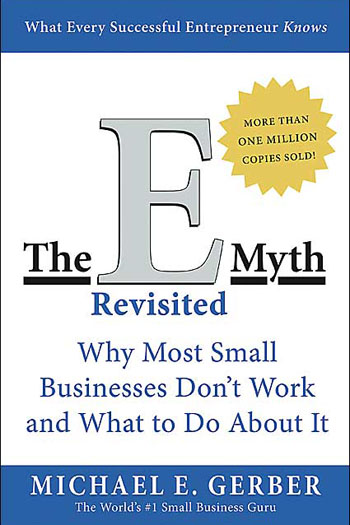If you own a small business or are considering starting one, put this book at the top of your “must read list.” As a business coach, I recommend the E-Myth Revisited to all my entrepreneurial clients.
In this book Gerber cites the well-known failure rates for small business: 40% fail in 1 year. Of those who survive 1 year, 80% fail in 5 years, and of those who survive 5 years, another 80% fail. Based on these statistics Gerber hits it right on the head as most new businesses fail because of poor planning, a lack of organization and what I call “entrepreneurial disillusionment” — in other words, the owner of the business discovers that running a business doing what he or she loves is not what they thought it would be.
Over the years, Gerber has observed that the small business owners who fail often share a number of characteristics, while those who succeed do so not by luck, brains, or perseverance, but by taking a different approach. This book explains the approach that is necessary for a business to survive and thrive.
Gerber’s E-Myth Revisited offers three specific points with the most important being, “Work ON your business not IN it.” We are introduced to three working personalities: 1) the entrepreneur who always has ideas, 2) the manager who keeps everything organized, and 3) the technician who knows that “If it’s going to get done right, I’d better do it myself.”
Most small businesses are started by these “technicians”, these are people who are skilled at something and who enjoy doing that thing. When these technicians strike out on their own, they tend to continue doing the work they are skilled at, and ignore all the other aspects of business. Without clear goals and benchmarks, they soon find themselves overworked, understaffed, and eventually broke. Worst of all, they may burn out and come to hate the work they do. Rather than owning a business, they own a job, and they find themselves working for managers who are completely clueless about how to run a business – themselves.
Gerber uses as an example, a woman who had begun a small bakery business because of her legendary pie making skills. Since she knew how to bake great pies, shouldn’t it follow that that skill could be the basis for a successful business? Back in the real world, while the business hadn’t exactly failed, it hadn’t exactly succeeded, either.
Gerber advocates looking at the large franchise models (McDonald’s being an example he uses in the book). The characteristic of the large franchise-based business is a detailed, finely tuned system that can be run successfully by non-experts. By asking us to consider the franchise approach, Gerber is not saying to go out and buy a franchise license. Instead, he says to imagine that you want to sell your business as a successful franchise within a finite period of time. If so, what will you need to do regarding your business plan in order to meet this goal?
If you’re a small business owner or if you’re thinking of going into business yourself, this book is a must read and can be of tremendous value.

